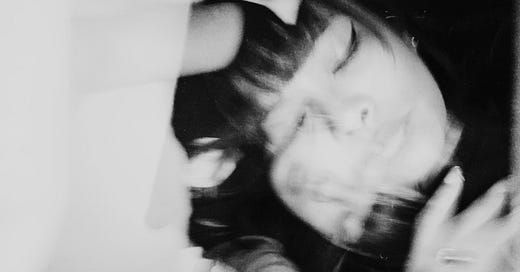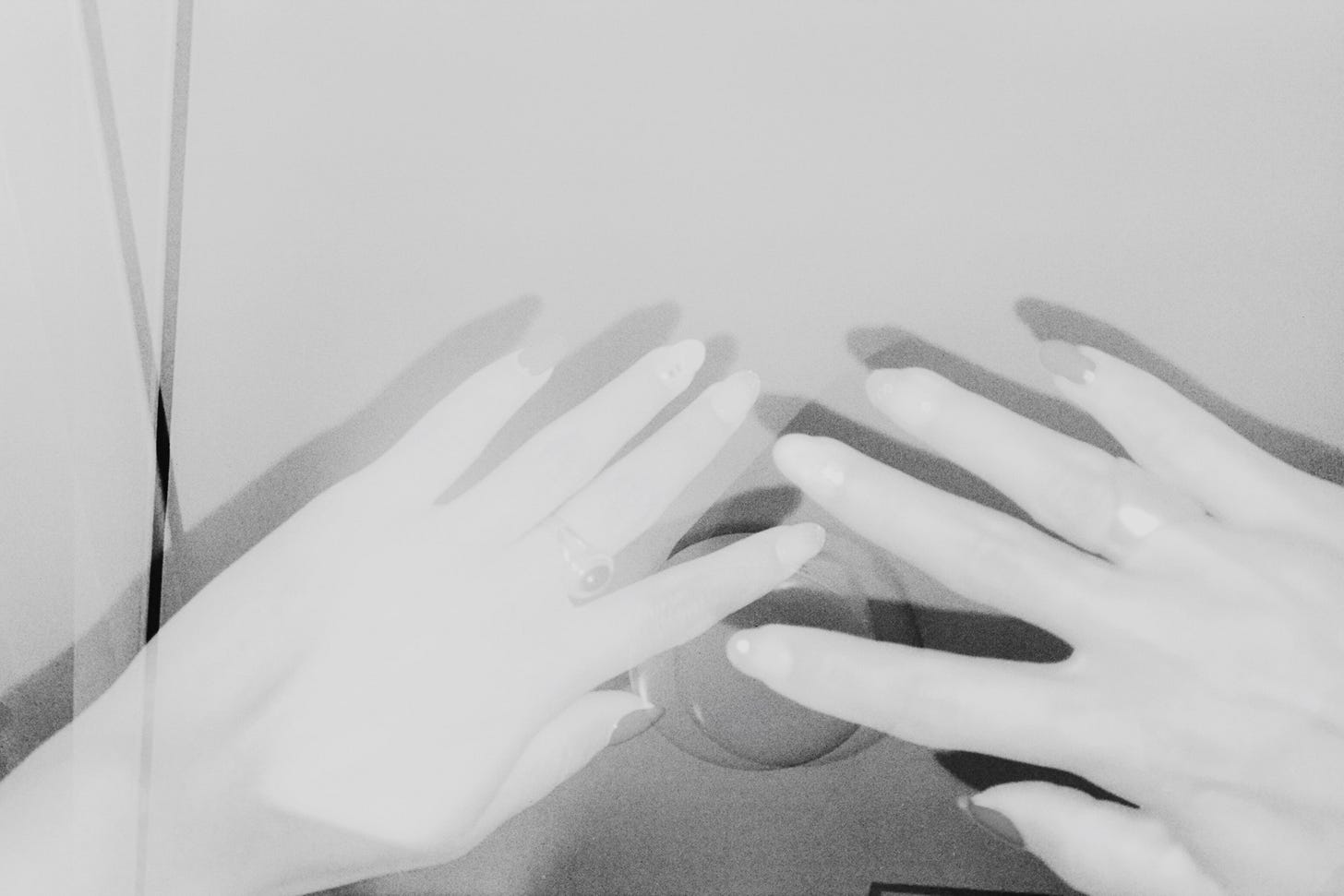Hello everyone,
If you're new to All Analogies, welcome! And if you're joining me from Analogies3, you might recall that it was quite a journey through the past year at Ephemere. We explored a whole bunch of publications and exhibitions, with a few personal detours along the way. Don't worry, I'll be sharing more about our projects in future posts. I realized that trying to squeeze everything into one can be a bit overwhelming!
This time, I want to focus on a single theme that's been on my mind lately—duality. It's a concept that's deeply intertwined with my love for photography, my approach to publishing, and even my everyday life.
Remember those "Magic Eye" posters that were all the rage in the 90s? You know, the ones with the hidden 3D images that only revealed themselves if you stared at them long enough (or were you one of the lucky few who could see them instantly)? Well, I've been thinking a lot about duality lately, and it's kind of like those Magic Eye posters. There's always more than meets the eye.
Duality is all around us. Light and shadow, stillness and motion, joy and sorrow, yin and yang – these contrasting elements coexist, shaping our experiences and perceptions. And as photographers, we have the unique ability to capture and explore these dualities through our images.
For me, the concept of duality first resonated deeply when I fell in love with black-and-white photography. There's something about the absence of color that heightens the contrast between light and shadow, revealing a world of textures and tones that might otherwise go unnoticed. It's a literal representation of duality, a visual reminder that everything exists in relation to its opposite.
But black-and-white photography is more than just aesthetics; it's also a way of thinking, a way of seeing the world. When I started focusing on black and white, I began to see things differently, not just through the lens of my camera, but also in my everyday life. I became more attuned to the interplay of contrasting elements, the subtle nuances that create depth and complexity.
This heightened awareness of duality has influenced not only my photography but also my personal and professional life. As a publisher, I'm constantly navigating the space between contrasting ideas and perspectives. I strive to create a balance between the creative and the analytical, the intuitive and the strategic. And I've learned that embracing duality, rather than fearing it, can lead to greater understanding, growth, and innovation.
The Black and White Lens: A Personal Reflection
To elaborate, my connection to black-and-white photography isn't just about visual presentation; it's about a fundamental shift in how I perceive the world. When I consciously decided to focus on this medium, it wasn't just my photos that became devoid of color—it was my entire visual experience. I started noticing the play of light and shadow in everyday scenes, the way textures and patterns stood out in the absence of vibrant hues. It was like living in a classic film noir, but, you know, with less trench coats and more cats. 🐈⬛
This wasn't just a photographic exercise; it became a lifestyle. I found myself drawn to black and white in my clothing, in my home décor, and even in my thoughts. It was as if the simplicity of black and white provided a sense of clarity and focus, allowing me to see beyond the surface and delve into the essence of things.
But as I've grown, I've also come to understand that life isn't always black and white. There are gray areas, nuances, and complexities that can't be easily categorized. And I've learned that embracing these gray areas, rather than fearing them, is essential for personal growth and understanding.
Those Diptych Daze: Finding Meaning in Uncertainty
During the early days of the pandemic, when the world felt like a surreal and uncertain place, I found myself drawn to the concept of diptychs as a way to explore the contrasting emotions and experiences of that time. I would challenge myself to create a diptych every day, capturing scenes from my commute and pairing them together to create a visual dialogue.
My daily commute, once a mundane routine, became a surreal journey through a city transformed. Shibuya Station, usually a bustling hub of activity, was eerily quiet, the masked faces of commuters adding to the sense of unease. I was drawn to capturing these moments of "doom and gloom," the empty streets, the closed shops, the sense of isolation.
But amidst the darkness, I also found moments of beauty and resilience. I captured images of nature reclaiming urban spaces, of small acts of kindness between strangers, of quiet moments of reflection. These diptychs became a way for me to process the complexities of that time, to find meaning in the midst of uncertainty, and to connect with others through a shared visual language.
One diptych, in particular, stands out in my memory. It features a double self-portrait, one image capturing my face with a blurred movement effect, and the other capturing my overexposed hands. The contrast between the movement and stillness, the light and shadow, mirrored the internal conflict I was experiencing at the time—the daily "unknown vibe," the constant feeling of uncertainty.
This project, which I aptly titled DYPSCHITS (a playful anagram and a solid nod to the frustrations of the pandemic—and yes, it wasn't inspired by "Schitt's Creek," though I super love that show!), became more than just a creative exercise; it became a form of therapy, a way to make sense of a world turned upside down. I shared my daily updates on Instagram, and the project unfolded organically, reflecting the ever-changing landscape of those times. It also helped me hone my skills as a photographer and storyteller, teaching me to be more mindful and intentional in my image-making.
The process of creating these diptychs also deepened my understanding of sequencing and visual storytelling, which has been invaluable in my work as a photobook publisher. I learned to see the connections between images, to create a narrative flow that draws the viewer in and keeps them engaged. The project resulted in two sold-out A6-sized photobooks, marking a significant step in my journey as an artist and publisher. It was one of my favorite projects to date, and it solidified my passion for photography as a means of personal expression and connection. ⚫️
And perhaps most importantly, this project reminded me of the power of photography to heal and connect us, even in the most challenging of times. It's a reminder that I carry with me as I continue to explore the world of photography and publishing, always seeking out new ways to share stories and create meaningful experiences.
If you're interested in seeing the DYPSCHITS project come to life in motion, I collaborated with a musician and video editor under my previous artist name, Erin Cross, to create a slideshow video which I used in a group exhibition in Yoyogi-Uehara in late 2020.
Continuing the Dialogue: Exploring Duality Through Diptychs
Now that you've seen my journey with duality through DYPSCHITS, I'm eager to invite you to join the conversation. I've always believed in the power of visual dialogue, and I'm excited to see how other photographers interpret the inherent contrasts of life through their images.
I'm excited to invite you to participate in Ephemere's 7th open call, where we'll be exploring the theme of duality through diptychs. This is a chance to delve into the contrasts that shape our world and express your unique perspective through the pairing of images.
We're looking for diverse interpretations of duality, from the subtle interplay of light and shadow to the more overt expressions of opposing forces.
Here's a glimpse of what's in store:
Deadline: March 31st, 2024, at 11:59 PM JST.
Submission Options: We offer a range of submission tiers to suit various preferences.
Co-Curator Opportunity: We're also seeking passionate artists to join our co-curator team for the final publication selection.
If you're ready to join the visual dialogue and explore the fascinating realm of duality, you can find all the details and submit your work here: Open Call #7: Duality — color photography is welcome!
We’ve already received amazing submissions and I can't wait to see your interpretations of this fascinating theme!
Analogy of the Day
"A diptych is like a conversation between two photographs, where each image speaks to the other, creating a narrative that is greater than the sum of its parts."
Thank you for joining me on this exploration of duality. I hope you found this piece insightful and perhaps even inspiring. If you have any thoughts or reflections on duality, diptychs, or anything else we've discussed, please share them in the comments below – I'd love to hear from you!
Creating these All Analogies posts takes time and dedication, and your support means the world to me. If you enjoy my series, please consider sharing it with your friends and fellow photography enthusiasts, or even becoming a paid subscriber.
Looking ahead, I'm excited to delve deeper into the world of independent photobook publishing in my next post. I'll be sharing some of my thoughts and experiences, as well as insights into the challenges and rewards of this unique creative path. Stay tuned!
And if you're looking for more special updates from me, you can join me on my Instagram broadcast channel. 🖤






